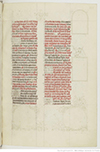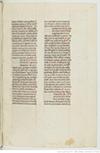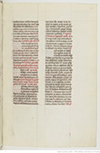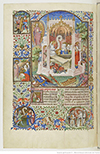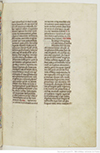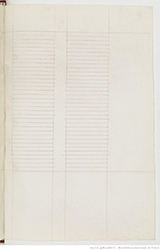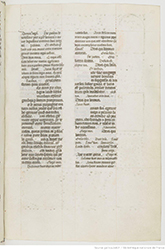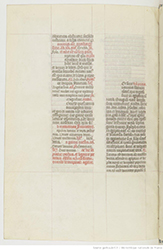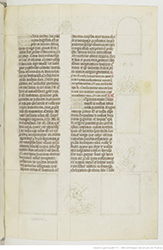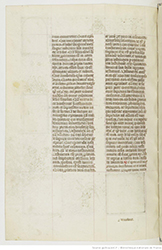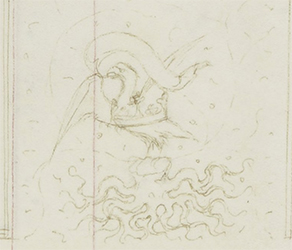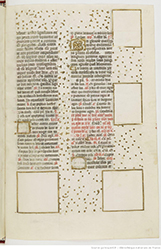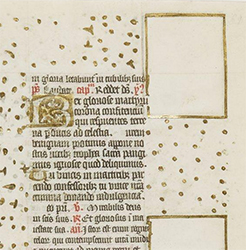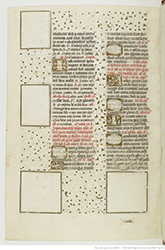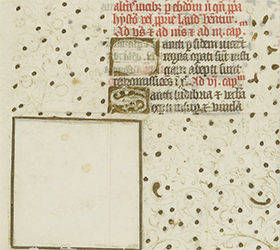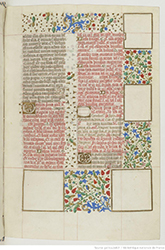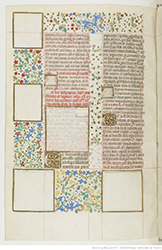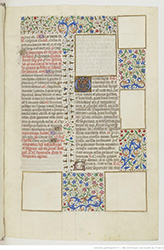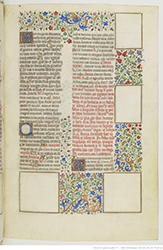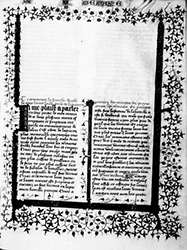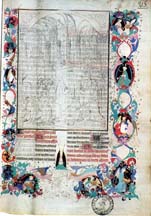Marginal Matters | Catalog of Decorators | Catalog of Manuscripts
A cursory examination indicates the basic working units and primary objectives in the illumination of the manuscript. The first task was the decoration and illustration was the decoration and illustration of the leaves with the large miniatures. Leafing through the manuscript, one finds leaves bearing finished large miniatures with completely decorated and illustrated rectos and versos and conjugate folios, while the other leaves in the gathering remain in only preliminary stages of execution. This occurs in the gathering formed by folios 223-230 containing the large miniature of the Visit to the Holy Sepulcher (folio 228v).
Folios 228 and its conjugate, folio 225, are completely decorated and illustrated. The two contiguous bifolios (folios 224/229; 226/227), however, have only completed text and rubrics, and the outside bifolio of the gathering (folios 223/230) has sketches for the borders and initials. This practice of separating a bifolio bearing a major pictorial unit from the other leaves in a gathering is found frequently in Parisian books of the period. This demonstrates that, after the gathering, the individual bifolio was a basic working unit. The first part of the manuscript to folio 182 is virtually finished save for minor details, but after this, a meaningful pattern of completion is obscure. Gatherings with virtually complete decoration and illustration are found to be contiguous with gatherings which have only completed text and rubrics. It is clear that the manuscript was not decorated and illustrated consecutively, but rather large miniatures with special connections to the Duke of Bedford and his wife Anne of Burgundy were given special attention during early stages of production. For example, on folio 518r, a large miniature of the Holy Family introduces texts dedicated to St. Anne with a historiated initial showing Anne of Burgundy. On the basis of its miniature style and border decoration, this miniature was completed at an early stage. This appears in a gathering (folios 516-523) in which only the bifolio (folios 518/521) containing this miniature is completed. The remaining bifolios only have completed text and not even completed rubrics. The previous gathering (folios 508-515) that contains a large miniature dedicated to St. James (f. 515v) is entirely completed, but the border and miniature styles suggest a later stage in production. Catherine Reynolds has demonstrated the importance of an examination of border styles along with miniature styles in determining the chronology of production of this complex manuscript. It is clear that the scribal work, decoration, and illustration were considered to be discrete processes. As shown in the examples below, the scribal work can be broken down into discrete stages from the ruling of the page to the writing of the text to the addition of rubrics.
The scribal work provides the basic framework for the contributions of the decorators and the miniaturists. On the leaf folio 195v, twelve lines have been left blank at the top of the inside column of the text for a small miniature, and spaces have been provided for initials. Small guide letters have been left for the initials. With the completion of the scribal work, the decoration could begin. It is in the sphere of the secondary decoration that the unfinished portions of the Salisbury Breviary are most instructive. Borders and initials can be found in different stages of completion from preliminary drawings to the finished product. Study of these unfinished sections demonstrates definite stages in the execution of the secondary decoration, and provides valuable hints as to the responsibilities and working habits of the decorators.
When the text and rubrics were completed, the first step in the decoration of the sheet was preliminary drawings. Here it should be emphasized that sketches for all the elements of the secondary decoration were executed contemporaneously. Guides for the miniature frames, basic border motifs, and the designs for the initials were supplied at this stage. There is no evidence for a division of labor in the execution of the sketches for the borders and the initials. The same ink was used for both. The decorator was undoubtedly provided with certain instructions for the lay-out of the decoration of the page. The basic border and initial types as well as the lay out of the page with small miniatures set into the borders would already have been determined. Spaces would also have been left in alternate initials for historiation.
Study of the sketches provides valuable insights into the working habits of the decorators. The border decoration and the frames of the marginal miniatures correspond on the recto and the verso. Comparison of the sketches on both faces of foilio 214 demonstrates that the drawings on the recto were executed first and then were traced through to the verso. The drawing on the recto is more detailed with the eagle in the lower margin being more carefully drawn. The style and quality of this drawing indicates an early stage in the production of the manuscript. The eagle on folio 214r can be compared to one on folio 518v, clearly decorated early. On folio 214r, faint lines define the patterns of the penned rinceaux and the placement of the gold leaves. The treatment of the eagle on the verso is more summary, and lacks the vitality and subtlety of line of the drawing on the recto. The guides for miniature frames and the patterns of the penned rinceaux have not been traced through, but even in the photograph, the shadows from the lines on the recto can be seen through the fine vellum leaf. This indicates the ease with which a pattern could be traced through from one side of a leaf to the other. This tracing from one side to the other avoided the distraction of being able to see the shadow of the other side of the leaf due to the thinness of the parchment. It also was clearly a labor saving device. Comparison of this leaf to the others in the gathering demonstrates that this decorator first executed drawings on the hair side of the sheets and then traced them through to the flesh sides. Consequently, the original sketches appear on alternate openings of the gathering. In other gatherings, the sketches were drawn first on the outside faces of the bifolios and then traced through to the inside faces. The original sketches thus appear on the rectos in the first half of the gathering and on the versos in the second half. Both methods demonstrate the importance of the face of a bifolio as a basic working unit. Observation of such differences in working habits can provide valuable criteria in identifying the contributions of various decorators.
After the sketches were completed, the gold leaf was laid down on the page. As in the case of the sketches, all aspects of the secondary decoration were treated at the same time. The gold for the ivy leaves in the borders, the initials, and the frames of the miniatures was applied at this stage. Even the gold for the pen-flourish one-line initials was added, even though, as will become evident, these pen flourish decorations were completed at a separate stage after the other secondary decoration was finished. Again the two surfaces of the leaf were treated differently. On folio 688v, the preliminary drawings for the border decoration are clearly visible. In contrast, there are no preliminary drawings evident in the border decoration of the recto of the leaf. Due to the thinness of the parchment, there was probably the intention to trace these drawing through when the painting stage began. The sketches were drawn on the outside faces of the bifolios. The drawings thus appear on the rectos in the first half of the gathering and on the versos in the second half.
With the addition of the gold leaf, the painting of the leaf could begin. Here it seems the first concern was the painting of the acanthus and floral decoration in the borders. The painting of the bodies and ivy-leaf infills of the initials was apparently left to a later and, unfortunately, not clearly documented stage. Distinct stages can be defined within the painting of the border acanthus and floral decoration. First the basic colors were laid down, and when the had had dried, modelling and fine detailing could be executed. These distinct steps in the painting of the acanthus and floral decoration provide further evidence of the basic working units. Examination of both faces of folio 328 reveals that only the basic colors have been applied to the verso, while shading and fine detailing are evident on the recto of the leaf. Its conjugate folio (folio 333) shows a similar pattern with the recto having only basic colors, while the execution of the verso has advanced to the stage of fine detailing. This demonstrates again the treatment of the respective faces of the parchment sheet as distinct working units. Even on the same surface of a bifolio different stages can be detected with the different colors on a page being treated separately. This is well illustrated by folio 33v. The green leaves and stems have been completed with shading and fine detailing, while the blue, mauve, and some of the red plants have only the basic coloring. The strawberries at the top of the page have some basic shading but no fine detailing.
The next stage evident in the unfinished portions of the Salisbury Breviary was the completion of the text and border decoration. The penned rinceaux was added, and the gold leaves and balls were outlined in black ink. The gold ground initials and their foliate infills were painted with spaces left blank in alternate initials for historiation. As demonstrated by the example of folio 186r, while the gold bodies of the pen flourish initials were added with the other gold decoration of the page, the addition of pen decoration was left to a separate stage and specialist to complete. Except for this, there is no indication of a division of labor between text and border decoration on a page. All the secondary decoration in working unit was worked on concurrently. There is no evidence for the involvement of separate text and border specialists. The manuscript offers no examples of completed border decoration and unfinished text decoration except for the historiated initials or vice versa. This conclusion is consistent with the examination of completed manuscripts of the period. The general rule is that a specialist was responsible for the border and text decoration within a working unit. As a general rule, a unity can be defined in the treatment of the diverse elements in the border and text decoration that suggests the work of a single craftsman.
It is with the completion of the secondary decoration that a bifolio could be handed over to the miniaturist. Examples like the one illustrated above can be found with completed secondary decoration and gaps left for the addition of miniatures.
As noted earlier, the Salisbury Breviary offers no examples of the illustration of a page beginning before the decoration was completed. This is a general rule in Parisian manuscript production, but is not a universal rule. A striking exception can be found in a work seen as a possible early work of the Bedford Master. In the Mazarine collection (Ms 406), there is an unfinished Missal intended for the Dauphin, Louis de Guyenne. For the bulk of the manuscript, the secondary decoration is completed. The missal currently contains no completed miniatures. The only miniatures that were completed were cut out (folios 20r, 23v, 94v, 159v, 225r, 228v, 230r). Elsewhere while the decoration was completed, gaps were left for the addition of miniatures. This conforms to the general rule that the decoration and illustration were discrete stages. The exception to this is an unfinished frontispiece which has a preliminary drawing of the youthful Louis attending mass in Sainte Chapelle. The border decoration is completed to the stage of laying in the basic colors for the acanthus decoration, but fine detailing, penned decoration, and the large initial have not been done. This suggests that the secondary decoration and the miniature were done concurrently on this page. The completed pen flourish initials indicates that these were done at a separate stage like in the Salisbury Breviary. This separation of miniature pages for special attention from the other leaves of the gathering and from other surfaces of the same bifolio is found in other manuscripts. For the Italian miniaturist dubbed the Master of the Brussels Initials regularly did the border decoration on pages he did miniatures for. Perhaps following the Italian Master's practice, the borders of miniature pages in a Book of Hours in the Bodleian Library in Oxford (Douce 144) were done by a different artisan from the other pages of the bifolios. For example, the decoration of folio 28v can be identified as the hand of the decorator I have named the A Master of the Belles Heures while the borders of recto of the leaf which marks the opening of Matins of the Hours of Virgin is done by a distinct decorator. Significantly, I think it is possible that this artisan is the same one who began work on the Mazarine Missal frontispiece.
|
